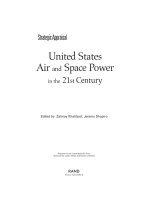- Trang chủ >>
- THPT Quốc Gia >>
- Hóa
The space race
Bạn đang xem bản rút gọn của tài liệu. Xem và tải ngay bản đầy đủ của tài liệu tại đây (3.61 MB, 10 trang )
Genre
Nonfiction
Comprehension Skill
Main Idea and Details •
•
•
•
Text Features
Captions
Charts
Diagrams
Glossary
Science Content
Technology
Scott Foresman Science 6.21
ISBN 0-328-14032-5
ì<(sk$m)=beadcj< +^-Ä-U-Ä-U
Vocabulary
Extended Vocabulary
autonomous robot
carbon nanotube
industrial robot
nanotechnology
robots
robotics
Cold War
cosmonaut
space probe
Space Race
space shuttle
space station
space walk
What did you learn?
1. What goal did President John F. Kennedy set for
the United States?
2. Why did NASA begin the space shuttle program?
3. Why did many politicians and world leaders view
space exploration as a military activity?
4.
5.
Picture Credits
Every effort has been made to secure permission and provide appropriate credit for photographic material.
The publisher deeply regrets any omission and pledges to correct errors called to its attention in subsequent editions.
Photo locators denoted as follows: Top (T), Center (C), Bottom (B), Left (L), Right (R), Background (Bkgd).
Opener ©Bettmann/Corbis; 1 ©Bettmann/Corbis; 3 NASA; 4 (BL) ©Bettmann/Corbis; 5 ©Ed Clark/Getty Images;
6 ©Bettmann/Corbis; 7 ITAR-TASS/Sovfoto/Eastfoto; 8 (TR) ©Bettmann/Corbis, (CL) Kennedy Space Center/NASA,
(BR) NASA/Science Source /Photo Researchers, Inc.; 9 (BR) ©Bettmann/Corbis; 11 (B) Corbis; 13 (B) ITAR-TASS/Sovfoto/
Eastfoto; 15 (CR) Johnson Space Center/NASA, (B) NASA.
Unless otherwise acknowledged, all photographs are the copyright © of Dorling Kindersley, a division of Pearson.
ISBN: 0-328-14032-5
Copyright © Pearson Education, Inc. All Rights Reserved. Printed in the United States of America.
This publication is protected by Copyright, and permission should be obtained from the publisher prior to any
prohibited reproduction, storage in a retrieval system, or transmission in any form by any means, electronic,
mechanical, photocopying, recording, or likewise. For information regarding permission(s), write to
Permissions Department, Scott Foresman, 1900 East Lake Avenue, Glenview, Illinois 60025.
3 4 5 6 7 8 9 10 V010 13 12 11 10 09 08 07 06 05
Space exploration gained a
lot of interest during the Cold War as a result of
competition between the United States and the
Soviet Union. Write to explain how today many
countries, including the United States and Russia,
work together.
by The
Grace
Ng
Main Idea and Details
launch
of Sputnik 1
by the Soviets was the event that initiated the
Space Race. One of the last events of the Space
Race was the development of a reusable
spacecraft. What were the most important events
that link these two milestones?
What You Already Know
Technology is continually improving. Robots have become
more common in science and industry because robotics has
improved over time. Other technologies, such as smaller, more
powerful computer systems, more precise sensors, and advanced
computer programs, have helped robot designers.
Robots affect many aspects of our lives. We use robots to
perform jobs that are too dangerous, boring, or repetitive for
people to do. They are also useful when the work needs to be
very accurate.
Almost 90 percent of robots are used in factories. They are
called industrial robots. The most common type is the robotic
arm. Robot arms can weld, paint, iron, assemble, pack, inspect,
and test manufactured parts. Hospitals use messenger robots to
carry supplies, equipment, and medications from one place to
another. Robotic hands, controlled by human surgeons, are now
being used in surgery.
Robots are also used to explore beyond Earth. NASA uses
remote-controlled vehicles called rovers. Rovers can explore
distant locations while being controlled by an operator. Robots
that do not need direct supervision or specific instructions before
acting are called autonomous robots. They can analyze data and
decide what to do next. Robots can be used to explore places
where humans cannot go and do jobs too dangerous for humans.
Nanotechnology is very small-scale technology that deals with
materials and processes measured in nanometers. Currently
researchers believe that nanotechnology will allow people to build
materials one atom at a time. With such precision, scientists
should be able to make any material they want. So far scientists
have not built many substances in this way. But they have had
success changing some existing materials.
2
In the future, scientists may be able to use a form of
technology called nanoshells to fight cancer. These shells are
injected into a tumor to kill the cancer cells using heat. Another
medical application involves nanocrystals that give off specific
colors of light. Researchers use these nanocrystals to locate and
identify individual chromosomes. Depending on how the crystals
glow, researchers can gather information about a patient’s DNA.
One of the most promising breakthroughs in nanotechnology
is the discovery of the carbon nanotube. Researchers think the
unique properties of these molecules could be used to
manufacture ultrasmall transistors and other electrical devices.
These devices may be ten times smaller than what we use today!
Space exploration is one field in which technology has
developed very rapidly. Political tensions between the United
States and the Soviet Union after World War II fueled
competition between the two countries in many areas. This
competition led to many technological innovations that
culminated in humans walking on the Moon!
The rovers Opportunity and Spirit
have sent back images of the surface
of the planet Mars.
3
The Race for Space
Throughout history, people have been curious
about what is beyond Earth. Such curiosity has
led some to study the stars and the planets
through telescopes. Others develop theories
and models to explain how the universe
functions. People have also been curious
about space travel and exploration. It has
been a topic of scientific inquiry and
fictional writing for hundreds of years.
The launch of Sputnik 1 on
However, one of the most rapid and
October 4, 1957, marked
important series of advances in space
the start of the Space Race.
exploration began in the 1950s.
Two countries, the United States and the Soviet Union, led
the world into an era of intense space exploration. After World
War II, the two countries had strong political differences. The
Cold War, a time of political disagreements and military rivalry,
did not end in actual combat. However, the United States and the
Soviet Union let this rivalry fuel many competitions, from sports
to space exploration.
History changed on October 4, 1957,
when Sputnik 1, the world’s first artificial
satellite, was launched into space. It
orbited Earth in about ninety-eight
minutes. This was a great victory for
the Soviets because they put a satellite
in orbit before the United States did.
In January 1958, the
United States successfully
launched a satellite,
called Explorer 1, on
a Juno 1 rocket.
4
The Cold War
From 1945 to 1990 there
was great distrust and
misunderstanding between
the United States and the
Soviet Union. Many feared this
distrust could lead to a world
war. Premier Khrushchev and
President Eisenhower were
leaders during the 1950s.
As the Soviets celebrated their success, most Americans had
a very different feeling. They feared that if the Soviet Union had
the ability to launch satellites, then they would also have the
ability to launch missiles that could carry nuclear weapons to any
location on Earth. Others thought that the Soviets’ satellite was
launched to get targeting information for these missiles. The
public was very frightened by what could happen in the future.
Many Americans also felt shocked. They were surprised that
the Soviets had technology that could rival that of the United
States. When the Soviets beat them into space, Americans lost
a lot of their pride. Immediately the U.S. Defense Department
approved more funding for its space program. On January 31,
1958, the United States successfully launched its own satellite,
called Explorer 1.
The launch of Sputnik 1 marked the beginning of the Space
Race. A long-term competition developed between the United
States and the Soviet Union to make discoveries in space. Both
wanted to be the leader in space exploration. During the Space
Race, scientists and government leaders from both countries
were under great pressure to meet some tough deadlines. They
developed and used many new technologies in a very short
period of time.
5
Humans in Space
Less than a month after the success of Sputnik 1, the Soviet
Union made another space launch. This time, Sputnik 2 carried
a dog named Laika. She was the first living creature launched
into space. Scientists in the Soviet Union believed organisms
could live in space. On this trip Laika proved it, though she only
survived for a short time as there was no way for her to return
to Earth. Sputnik 1 weighed less than 84 kilograms. Sputnik 2
weighed approximately 508 kilograms. It was much larger than
the 1.6 kilogram satellite designed by the United States. This led
many American scientists and leaders to believe that the Soviets
were preparing to send a human into space.
American leaders felt that the United States was far behind in
the Space Race. In 1958 Congress established a permanent
government agency dedicated to space exploration. The National
Aeronautics and Space Administration, or NASA, was formed.
NASA’s tasks were to plan and carry out space activities, to
involve scientists in these activities, and to spread information
about these activities to the American public.
American leaders wanted to catch up with the Soviet Union.
They believed that if the United States could be the first country
to send a person into space, they would catch up. However, a
Soviet astronaut, or cosmonaut, beat them by a
month. On April 12, 1961, Yuri Gagarin
became the first human in space.
He made a single orbit of
Earth in his Vostok 1
spacecraft.
Vostok 1 shook wildly when it reentered Earth’s atmosphere.
Once Gagarin was close enough to the ground, he ejected and
landed by parachute. It was a very proud moment for the Soviets.
They called Yuri the Columbus of the Cosmos.
The United States celebrated a smaller milestone on May 5,
1961, when Alan Shepard, Jr., became the first American in space.
He went on a fifteen-minute flight in a capsule called Freedom 7.
He reached a high altitude but did not orbit Earth as the Soviet
Gagarin had done. It was still a success for the United States.
Soviet Yuri Gagarin became an instant
international hero after he became the first
human in space. His orbit around Earth
took place in April 1961.
On November 3, 1957, a Soviet
dog named Laika became the
first living creature launched
into space. She traveled in
the satellite Sputnik 2.
6
7
More Firsts
Race to the Moon
As the Space Race became more
competitive, many milestones were achieved in
a very short period of time. John Glenn, Jr.,
became the first American to orbit Earth, on
February 20, 1962. He circled Earth three
Valentina Tereshkova
times in about five hours before returning.
Then on June 16, 1963, Soviet Valentina Tereshkova became
the first woman in space. She was in space for a total of three
days. Another major event was the first space walk, made on
March 18, 1965, by Soviet Aleksei Leonov. A space walk is any
kind of physical activity outside of a spacecraft. Leonov floated
outside the spacecraft for twenty minutes.
Both countries began sending space probes
to the Moon. A space probe is an unmanned
exploratory spacecraft. The first probes
were sent to pass very close to the Moon
or to crash-land on it. Probes were later
designed to orbit the Moon or to make
soft landings on it.
Soviet-made probes were the first to
accomplish each of these tasks. Luna 1
was the first probe to fly by the Moon.
Luna 2 was the first to crash-land on the
The Soviet Union was very
Moon, and Luna 9 was the first to make successful in launching its
a soft landing. Luna 10 was the first
space probes to the Moon.
Luna 9 was the first probe to
probe to orbit the Moon.
At this point, the Soviets had beaten make a soft landing on the
Moon’s surface.
the Americans to every space milestone.
Americans wanted to find some way to overtake the Soviets in
the Space Race. Then President John F. Kennedy gave a speech
to the American public. He stated that his goal was to land an
American on the Moon and return him or her safely to Earth.
This was a great challenge. The first country to accomplish this
goal would take the lead in
space exploration.
In 1965, cosmonaut Aleksei Leonov and
astronaut Edward White both made space
walks for their countries.
In February 1962, John
Glenn, Jr., became the first
American to orbit Earth.
He blasted off on board the
Friendship 7 spacecraft.
8
On May 25, 1961, President
John F. Kennedy gave a speech
in which he set out his plan to
land an American on the Moon
before the end of the decade.
9
American astronauts Neil Armstrong
and “Buzz” Aldrin were the first
humans to land on the surface of
the Moon.
On July 20, 1969, Eagle landed safely on the Moon,
and Neil Armstrong became the first human to set foot on the
Moon. He said, “That’s one small step for man, one giant leap
for mankind.” Edwin “Buzz” Aldrin, Jr., joined him on the
Moon. The two men collected rocks and soil samples, took
pictures, and set up scientific experiments. They spent about
two-and-a-half hours on the surface of the Moon. On July 24,
all three astronauts returned safely to Earth.
Millions of people on Earth were able to watch the events on
television because the astronauts had brought a
camera with them. Armstrong and Aldrin
even took a radio telephone call from
President Richard Nixon while on the
Moon’s surface. It was an extremely
exciting time for Americans. They had
beaten the Soviets to the Moon!
The Apollo 11 crew consisted
of Neil Armstrong, Michael
Collins, and “Buzz” Aldrin.
The Apollo program began on May 25, 1961. The objective
of this program was to land an American on the Moon and then
return him or her safely to Earth. NASA launched many different
Apollo missions in preparation for its final goal. Apollo 8 was
the first manned spacecraft to orbit the Moon.
After several successful missions, the United States was ready
to make history. On July 16, 1969, the crew of Apollo 11 took off
from Earth with the goal of landing on the Moon. The plan was
to have a lunar module called Eagle separate from the main
spacecraft, the command module Columbia. The lunar module
would land on the surface of the Moon while the command
module orbited the Moon.
10
“Buzz” Aldrin stands beside an
American flag on the Moon’s surface.
11
Reusable Craft
NASA did not stop with one mission to the surface of the
Moon. Between 1969 and 1972, NASA conducted more Apollo
missions. But these missions were very expensive.
NASA could not afford many more missions if it did not
cut down on costs. To cut costs, it developed the space shuttle,
a reusable spacecraft designed to transport people and cargo
between Earth and space. The space shuttle has four main
components: a reusable orbiter, a large fuel tank that is used
once, and two reusable booster rockets for the initial launch.
On April 12, 1981, the first U.S. space shuttle flew into space.
It was a great success because once again, the United States had
beaten the Soviet Union by developing a reusable system.
In 1981 the first U.S. space
shuttle was launched. This
marked the beginning of
NASA’s space shuttle program.
The space shuttle is a reusable
spacecraft. It has been the
United States’ only launch
spacecraft from the mid-1970s
through 2004.
Some Soviet politicians thought that the United States was
using the space shuttle for military purposes. So they created their
own reusable spacecraft program, called the Buran program. It
became the Soviet Union’s largest and most expensive space
program. The first and only launch of the Buran shuttle was on
November 15, 1988. Afterwards the program ended due to a lack
of money. Around this time the Cold War was ending, and the
Space Race ended as a result. By the end of 1991 the Soviet Union
splintered into fifteen independent countries, including Russia.
Unlike the Soviet program, America’s space shuttle program
grew. The space shuttle was the first spacecraft with the ability to
carry large satellites from Earth to space.
After the success of America’s space
shuttle, the Soviets created their own
reusable spacecraft, the Buran.
12
13
Working Together
Space exploration is no longer a competition between
countries. Instead, it is an international project. Russia built
the Mir space station from 1986 to 1996. A space station is a
place where people can live and work in space. Year after year,
astronauts, scientists, and researchers from all over the world
used the station.
In 1995 Norman Thagard became the first American
astronaut to visit Mir. He was aboard the space shuttle
Atlantis, which delivered water, supplies, and equipment for
medical experiments. It also delivered a docking module and
two solar arrays to expand the Mir space station.
The space shuttle Atlantis is docked
with the space station Mir in 1995.
14
This marked a new era in space
exploration. Different countries are
now working together toward a
common goal. Today sixteen
countries are building another
space station. Both Russia and the
United States are part of the team
that is building the International
Space Station (ISS). New modules
continue to be added to the station
all the time. Once it is finished, the
space station will be about the size
of a football field. It will allow
humans to explore space for many
years to come.
Space Linkup
On July 17, 1975, Apollo
18 and Soyuz 19 docked
together in Earth’s orbit
as part of a historic joint
project between the United
States and the Soviet Union.
Astronaut Tom Stafford and
cosmonaut Aleskei Leonov
shook hands in space.
The International Space Station is being
built by sixteen different countries.
15
Vocabulary
Glossary
Extended Vocabulary
autonomous robot
Cold War
carbon nanotube
cosmonaut
industrial robot
space probe
Cold War
the ideological conflict between the United
nanotechnology
Space Race
States and the Soviet Union
robots
space shuttle
robotics
space station
cosmonaut
a Russian or Soviet astronaut
space walk
space probe
an unmanned exploratory spacecraft
Space Race
the competition between the United States
and the Soviet Union aimed at making
discoveries in space
space shuttle
a reusable spacecraft designed to transport
people and cargo between Earth and space
space station
a place where people can live and work in
space for long periods of time
space walk
any kind of physical activity outside a
spacecraft by one of the crew
Picture Credits
Every effort has been made to secure permission and provide appropriate credit for photographic material.
The publisher deeply regrets any omission and pledges to correct errors called to its attention in subsequent editions.
Photo locators denoted as follows: Top (T), Center (C), Bottom (B), Left (L), Right (R), Background (Bkgd).
Opener ©Bettmann/Corbis; 1 ©Bettmann/Corbis; 3 NASA; 4 (BL) ©Bettmann/Corbis; 5 ©Ed Clark/Getty Images;
6 ©Bettmann/Corbis; 7 ITAR-TASS/Sovfoto/Eastfoto; 8 (TR) ©Bettmann/Corbis, (CL) Kennedy Space Center/NASA,
(BR) NASA/Science Source /Photo Researchers, Inc.; 9 (BR) ©Bettmann/Corbis; 11 (B) Corbis; 13 (B) ITAR-TASS/Sovfoto/
Eastfoto; 15 (CR) Johnson Space Center/NASA, (B) NASA.
Unless otherwise acknowledged, all photographs are the copyright © of Dorling Kindersley, a division of Pearson.
ISBN: 0-328-14032-5
Copyright © Pearson Education, Inc. All Rights Reserved. Printed in the United States of America.
This publication is protected by Copyright, and permission should be obtained from the publisher prior to any
prohibited reproduction, storage in a retrieval system, or transmission in any form by any means, electronic,
mechanical, photocopying, recording, or likewise. For information regarding permission(s), write to
Permissions Department, Scott Foresman, 1900 East Lake Avenue, Glenview, Illinois 60025.
3 4 5 6 7 8 9 10 V010 13 12 11 10 09 08 07 06 05
16
What did you learn?
1. What goal did President John F. Kennedy set for
the United States?
2. Why did NASA begin the space shuttle program?
3. Why did many politicians and world leaders view
space exploration as a military activity?
4.
Space exploration gained a
lot of interest during the Cold War as a result of
competition between the United States and the
Soviet Union. Write to explain how today many
countries, including the United States and Russia,
work together.
5.
Main Idea and Details The launch of Sputnik 1
by the Soviets was the event that initiated the
Space Race. One of the last events of the Space
Race was the development of a reusable
spacecraft. What were the most important events
that link these two milestones?









